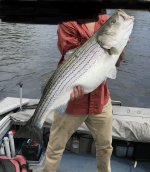afishinado
Moderator
Staff member
Article about the latest Chesapeake Bay spawning survey. Not good this year or for the past few years.

 www.onthewater.com
www.onthewater.com

Poor Spawn is Bad News for Striper Stock - On The Water
The Maryland Department of Natural Resources has shared bad news for the striped bass stock.
Last edited:




